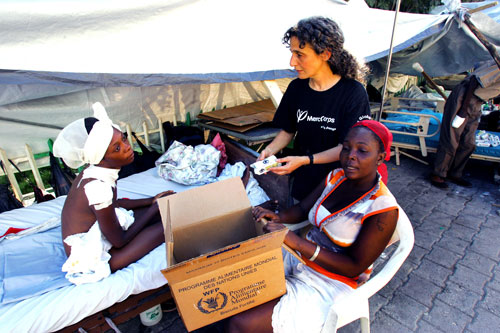 The Red Cross has raised about $255 million for Haiti, $32 million of it, 12.5%, by text message. Mercy Corps, which is much smaller, has raised $11.4 million from donors via the web, phone and in-person donations. But nothing by text.
The Red Cross has raised about $255 million for Haiti, $32 million of it, 12.5%, by text message. Mercy Corps, which is much smaller, has raised $11.4 million from donors via the web, phone and in-person donations. But nothing by text.
 |
Mercy Corps launched relief efforts in Haiti after the earthquake in late January.PHOTO COURTESY OF MERCY CORPS |
The 7.0 earthquake that laid waste to Port-Au-Prince was unique in its devastation. It was also the first major disaster to take place in the mobile age, as aid organizations for the first time accepted donations for a mass-scale crisis via text message.
Americans who followed news of the quake closely were repeatedly told to text “HAITI” or “QUAKE” to various aid organizations, which would seamlessly donate $5 or $10 to the relief effort. Of those who donated to Haiti, 14% did so by text message. That’s an impressive adoption rate, considering it’s the first time anybody had done it. “This is the first major emergency where texting has been a source of revenue for nonprofits at all,” says Jeremy Barnicle, marketing VP at Mercy Corps, a Portland-based nonprofit.
Within an hour of the quake, Mercy Corps decided to make Haiti a priority. But among the names of many aid organizations scrolling across cable news tickers next to their text message code words, Mercy Corps was conspicuously absent. The Red Cross has raised about $255 million for Haiti, $32 million of it, 12.5%, by text message. Mercy Corps, which is much smaller, has raised $11.4 million from donors via the web, phone and in-person donations. But nothing by text.
The Red Cross, through a partnership with the U.S. Department of State, was one of the first agencies to accept text donations for aid in Haiti. About two dozen organizations, including Oxfam, CARE and smaller organizations such as Yéle, quickly followed suit. Not all the aid groups in Haiti have enabled text giving, but it’s surprising that Mercy Corps hadn’t, given that it established itself as a major international player largely because it anticipated the last revolution in charitable fundraising: web-based giving. Mercy Corps outclassed bigger aid groups and quadrupled its revenue with a sophisticated web fundraising campaign after the Indian Ocean tsunami in 2004.
Mercy Corps was considering text giving, Barnicle says, but hadn’t made a decision at the time of the quake, weighing the pros of reaching new donors against the cons of the small dollar amounts and low engagement level required for text messaging. After two weeks, donations by all means had dramatically dropped off and Mercy Corps still didn’t offer text giving. The Haiti quake convinced them that text giving will be a necessary component of fundraising, Barnicle says, but it’s not a revolution.
“I don’t think texting per se is going to be the kind of quantum leap that web fundraising has been,” he says. Barnicle now considers it “a matter of course” for Mercy Corps.
But while it may have missed out on text giving, Mercy Corps hasn’t given up on innovative fundraising. A new feature on MercyCorps.org lets users create a personal fundraising website to raise money for Mercy Corps from friends and family. Users write a personal message about the cause and why it’s important to them, post photos, set a fundraising target and link to the page from Facebook, Twitter and email. Barnicle says that before the quake fewer than 100 people had signed up. After the quake, it was up to 3,000, bringing in more than $928,000 for the Haiti relief effort.
The personal pages require a sustained effort and high level of engagement, much more Mercy Corps’ style.


